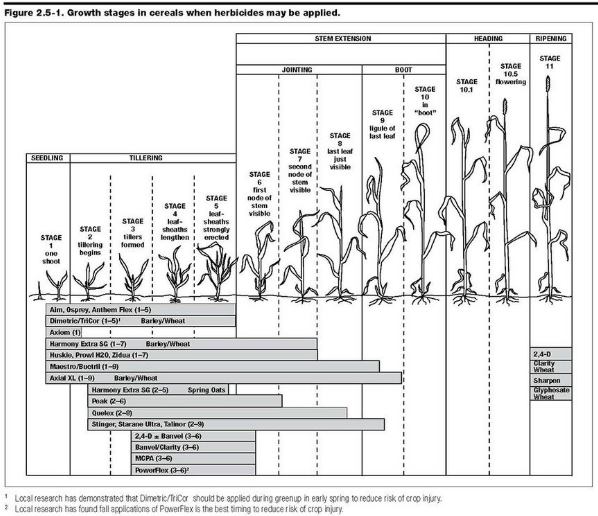By Dwight Lingenfelter
Populations of winter annual weeds become prevalent in late March/early April and can compete with wheat and barley and slow the rate of crop development potentially reducing yield. If winter annual weeds like common chickweed, henbit, purple deadnettle, marestail/horseweed, and others emerge with small grains and are left unchecked, the potential impact on yield could be great.
Harmony Extra is still probably the broadest spectrum herbicide for broadleaf control. Harmony SG contains only one of the active ingredients (thifensulfuron) in Harmony Extra and thus does not have the same weed control spectrum. Clarity, Banvel, 2,4-D, or MCPA can improve the control of some winter annuals and perennials and Stinger is the most effective small grain herbicide for thistles. Harmony SG or Harmony Extra should be included where control of chickweed is desired, since these are the only herbicides that control this weed, but if it is ALS-resistant than you will need to include Glory, Starane, or Quelex. Consider using 2,4-D and Clarity, Huskie, or Quelex if horseweed/marestail is a problem in small grains. Prowl H2O is also labeled for use up to growth stage 7 but it must be applied before weeds germinate or tank mixed with effective post herbicides. Refer to the Agronomy Guide ( Table 2.5-6 ) for additional details on herbicide effectiveness.
Herbicides applied in early spring can be slow to provide control under the typically cool conditions in March and early April. Remember that cool (less than 50oF) cloudy days can reduce herbicide activity. Applications this early are not likely to effectively control dandelions or Canada thistle. These weeds would be more effectively controlled with a later spring application.
Weedy grasses, such as downy brome, cheat, annual bluegrass, annual ryegrass, and roughstalk bluegrass are also becoming more of a problem in Pennsylvania. The wheat herbicides that are available for control of grasses include Axial, Maverick, Osprey, PowerFlex and Prowl H2O, are they are most effective when applied in the fall. Some of these products can work in the spring, but to be effective the weeds must be small, or in the case of Prowl, it must be applied before weeds germinate.
Herbicide selection for broadleaf weeds in winter wheat past Feeke’s Stage 6
Once wheat has passed Feeke’s Stage 6 (i.e., when the first node of stem is visible), the risk of herbicide injury from 2,4-D, MCPA, Banvel/Clarity, or Curtail increases and application of these herbicides is not recommended. In this situation, the remaining herbicide options for broadleaf weed control are Harmony Extra (similar products: Edition, Treaty Extra, Nimble, others), Harmony SG (similar products: Treaty, Harass, Volta), Buctril, Stinger and Starane. Harmony Extra and Harmony SG (and the similar products listed above) can be applied to wheat until the flag leaf is visible (before Feeke’s Stage 8). Buctril, Huskie, Stinger and Starane can be applied to wheat up to boot stage (before Feeke’s Stage 9).

Each spring there are questions about the risks associated with 2,4-D or MCPA application to wheat past Feeke’s Stage 6. Wheat tolerance of 2,4-D is highest between Feeke’s stages 3 and 6 and is lowest in Feeke’s Stages 9 and 10. Between stages 6 and 9, sensitivity to 2,4-D gradually increases as wheat growth stage advances. Thus, the risk of injury increases as wheat growth stage advances between stages 6 and 9. Severe injury is likely when 2,4-D is applied at Feeke’s stages 9 and 10.
It is recommended that application of 2,4-D to wheat be made after wheat has reached Feeke’s stage 3 but prior to Feeke’s stage 6. If growers choose to apply 2,4-D at later stages, they need to understand the associated risk. This risk can be minimized by applying the amine form of 2,4-D or reducing the rate of a 2,4-D ester. A much better alternative on wheat past Feeke’s stage 6 is to use another broadleaf herbicide with a wider application window that is effective on the weeds present in the field.
Herbicide carrier selection
Liquid urea-ammonium nitrate fertilizer (UAN) is a common carrier for herbicides in wheat. The most common herbicide to be used in this manner is 2,4-D ester (2,4-D amine is difficult to mix in UAN). Application of herbicides in liquid nitrogen can cause leaf burn from the nitrogen, especially under hot, humid conditions. This risk increases with later wheat growth stages because more leaf area is exposed to the treatment and recovery time is shorter. In addition, the use of surfactant (required with herbicides such as Harmony Extra) greatly increases leaf burn potential. Research at Michigan State University has demonstrated that excessive leaf burn from high nitrogen rates combined with surfactant can reduce wheat yield. To minimize this risk:
- Do not apply more than 20 lbs of nitrogen per acre in the form of UAN when using a surfactant with herbicide.
- Do not apply more than 40 lbs of nitrogen per acre in the form of UAN when no surfactant is used.
- Avoid high-temperature, high-humidity days. Late afternoon applications carry less risk of leaf burn.
Below are the specific adjuvant recommendations for Harmony SG and Harmony Extra
SG:
Source: psu.edu